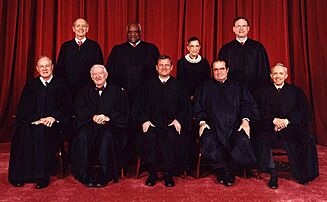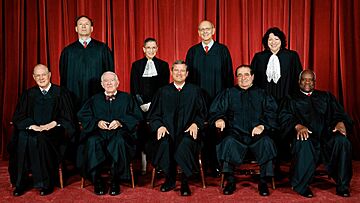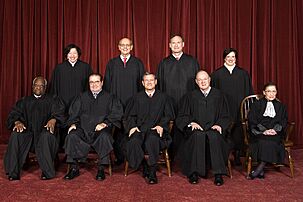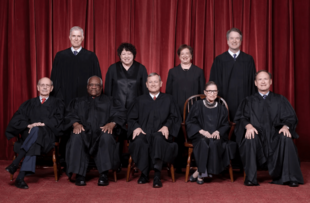Roberts Court facts for kids
| Roberts Court | |
|---|---|
|
Rehnquist Court ←
→ Current
|
|
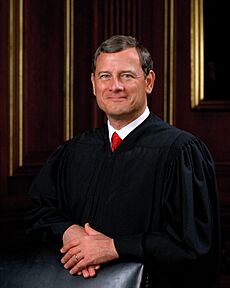
|
|
| September 29, 2005 – 19 years, 209 days |
|
| Seat | Supreme Court Building Washington, D.C. |
| No. of positions | 9 |
| Roberts Court decisions | |
 |
|
The Roberts Court is the time since 2005 during which the Supreme Court of the United States has been led by John Roberts as Chief Justice. Roberts succeeded William Rehnquist as Chief Justice after Rehnquist's death.
It has been considered to be the most conservative court since the Vinson Court (1946–1953). This is due to the retirement of the relatively moderate Justice Sandra Day O'Connor and the confirmation of the more conservative Justice Samuel Alito. The ideological balance of the court shifted further to the right in the following years through the replacement of swing-vote Anthony Kennedy with Brett Kavanaugh in 2018 and the replacement of liberal Ruth Bader Ginsburg with Amy Coney Barrett in 2020.
Since the appointment of Barrett, the Roberts Court has become the most unpopular Court since polling started by Gallup in 1973.
Membership
Roberts was originally nominated by President George W. Bush as an associate justice to succeed Sandra Day O'Connor, who had announced her retirement, effective with the confirmation of her successor. However, before the Senate could act upon the nomination, Chief Justice William Rehnquist died. President Bush quickly withdrew the initial nomination and resubmitted it as a nomination for Chief Justice; this second Roberts nomination was confirmed by the Senate on September 29, 2005, by a 78–22 vote. Roberts took the constitutional oath of office, administered by senior Associate Justice John Paul Stevens (who was the acting chief justice during the vacancy) at the White House after his confirmation the same day. On October 3, Roberts took the judicial oath provided for by the Judiciary Act of 1789, prior to the first oral arguments of the 2005 term. The Roberts Court commenced with Roberts as Chief Justice and the final eight associate justices from the Rehnquist Court: Stevens, O'Connor, Antonin Scalia, Anthony Kennedy, David Souter, Clarence Thomas, Ruth Bader Ginsburg, and Stephen Breyer. President Bush's second nominee to replace O'Connor, Harriet Miers, withdrew before a vote; Bush's third nominee to replace O'Connor was Samuel Alito, who was confirmed in January 2006.
In 2009, President Barack Obama nominated Sonia Sotomayor to replace Souter; she was confirmed. In 2010, Obama nominated Elena Kagan to replace Stevens; she, too, was confirmed. In February 2016, Justice Scalia died; in the following month, Obama nominated Merrick Garland, but Garland's nomination was never considered by the Senate, and it expired when the 114th Congress ended and the 115th Congress began on January 3, 2017. On January 31, 2017, President Donald Trump nominated Neil Gorsuch to replace Scalia. Democrats in the Senate filibustered the Gorsuch nomination, which led to the Republicans exercising the "nuclear option". After that, Gorsuch was confirmed in April 2017. In 2018, Trump nominated Brett Kavanaugh to replace Kennedy; he was confirmed. In September 2020, Justice Ginsburg died; Trump nominated Amy Coney Barrett to succeed Ginsburg and she was confirmed on October 26, 2020, days before the 2020 election.
In 2022, Breyer announced his retirement effective at the end of the Supreme Court term, assuming his successor was confirmed, in a letter to President Joe Biden. Biden nominated Ketanji Brown Jackson to succeed Breyer, and she was confirmed by the Senate. Breyer remained on the Court until it went into its summer recess on June 30, at which point Jackson was sworn in, becoming the first black woman and the first former federal public defender to serve on the Supreme Court.
Timeline
Other branches
Presidents during this court have been George W. Bush, Barack Obama, Donald Trump, and Joe Biden. Congresses included the 109th through the current 118th United States Congresses.
Rulings of the Court

The Roberts Court has issued major rulings on incorporation of the Bill of Rights, gun control, affirmative action, campaign finance regulation, election law, capital punishment, LGBT rights, unlawful search and seizure, and criminal sentencing. Major decisions of the Roberts Court include:
- Massachusetts v. EPA (2007)
- Medellín v. Texas (2008)
- District of Columbia v. Heller (2008)
- Kennedy v. Louisiana (2008)
- Ashcroft v. Iqbal (2009)
- Citizens United v. Federal Election Commission (2010)
- National Federation of Independent Business v. Sebelius (2012)
- Arizona v. United States (2012)
- Shelby County v. Holder (2013)
- Burwell v. Hobby Lobby (2014)
- Riley v. California (2014)
- Obergefell v. Hodges (2015)
- Whole Woman's Health v. Hellerstedt (2016)
- Trump v. Hawaii (2018)
- Janus v. AFSCME (2018)
- Timbs v. Indiana (2019)
- Rucho v. Common Cause (2019)
- Bostock v. Clayton County (2020)
- Espinoza v. Montana Department of Revenue (2020)
- Dobbs v. Jackson Women's Health Organization (2022)
- Kennedy v. Bremerton School District (2022)
- Moore v. Harper (2023)
- Students for Fair Admissions v. Harvard & Students for Fair Admissions v. University of North Carolina (2023)
- 303 Creative LLC v. Elenis (2023)
- Trump v. Anderson (2024)
- Loper Bright Enterprises v. Raimondo (2024)
- Trump v. United States (2024)
Gallery




